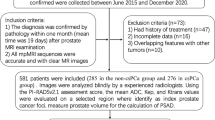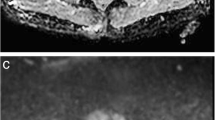Abstract
Purpose
To compare and analyse the diagnostic value of PI-RADS v2.1 when used with biparametric MRI (bpMRI) versus multiparametric MRI (mpMRI), DWI versus T2WI to detect peripheral-zone prostate cancer (pzPCa) and clinically significant peripheral-zone prostate cancer (cs-pzPCa).
Methods
The diagnostic efficiencies of mpMRI and bpMRI as well as DWI and T2WI in pzPCa and cs-pzPCa were compared using a PI-RADS score of ≥ 4 as the positive threshold and prostate biopsy and radical prostatectomy as the reference standards.
Results
A total of 307 prostate cases were included in the study, including 142 in the non-pzPCa group, 165 in the pzPCa group, and 130 in the cs-pzPCa group. The AUCs of mpMRI and bpMRI were 0.717 and 0.733 (P = 0.317), respectively, for the diagnosis of pzPCa (sensitivities: 89.1% and 81.8%; specificities: 54.2% and 64.8%, both P < 0.001) and 0.594 and 0.602 (P = 0.756), respectively, for the diagnosis of cs-pzPCa (sensitivities: 93.1% and 86.2%, P = 0.004; specificities: 25.7% and 34.3%, P = 0.250). The AUCs of DWI and T2WI were 0.733 and 0.749 (P = 0.308), respectively, for the diagnosis of pzPCa (sensitivities: 81.8% and 84.2%; specificities: 64.8% and 66.2%, both P > 0.05) and 0.602 and 0.581 (P = 0.371), respectively, for the diagnosis of cs-pzPCa (sensitivities: 86.2% and 87.7%; specificities: 34.3% and 28.6%, both P > 0.05).
Conclusion
mpMRI and bpMRI as well as DWI and T2WI using PI-RADS v2.1 exhibited similar diagnostic efficiency in pzPCa and cs-pzPCa.








Similar content being viewed by others
Abbreviations
- ADC:
-
Apparent diffusion coefficient
- AUC:
-
Area under curve
- bpMRI:
-
Bi-parametric MRI
- cs-pzPCa:
-
Clinically significant peripheral-zone prostate cancer
- DCE:
-
Dynamic contrast enhanced
- DWI:
-
Diffusion weighted imaging
- mpMRI:
-
Multi-parametric MRI
- NPV:
-
Negative predictive value
- PCa:
-
Prostate cancer
- PI-RADS:
-
Prostate Imaging Reporting and Data System
- PPV:
-
Positive predictive value
- PSA:
-
Prostate-specific antigen
- pzPCa:
-
Peripheral-zone prostate cancer
- ROC:
-
Receiver operating characteristic curve
- T2WI:
-
T2-weighted imaging
References
Chen W, Zheng R, Baade P D et al (2016) Cancer statistics in China, 2015. CA Cancer J Clin 66(2):115–132
Bray F, Ferlay J, Soerjomataram I et al (2018) Global cancer statistics 2018: GLOBOCAN estimates of incidence and mortality worldwide for 36 cancers in 185 countries. CA Cancer J Clin 68(6):394–424
Siegel R L, Miller K D, Fuchs H E et al (2021) Cancer Statistics, 2021. CA Cancer J Clin 71(1):7–33
Teoh J, Hirai H W, Ho J et al (2019) Global incidence of prostate cancer in developing and developed countries with changing age structures. PLoS ONE 14(10):e221775
Turkbey B, Brown A M, Sankineni S et al (2016) Multiparametric prostate magnetic resonance imaging in the evaluation of prostate cancer. CA Cancer J Clin 66(4):326–336
Ueno Y, Tamada T, Bist V et al (2016) Multiparametric magnetic resonance imaging: Current role in prostate cancer management. Int J Urol 23(7):550–557
Barentsz J O, Richenberg J, Clements R et al (2012) ESUR prostate MR guidelines 2012. Eur Radiol 22(4):746–757
Gupta R T, Mehta K A, Turkbey B et al (2020) PI-RADS: Past, present, and future. J Magn Reson Imaging 52(1):33–53
Turkbey B, Rosenkrantz A B, Haider M A et al (2019) Prostate Imaging Reporting and Data System Version 2.1: 2019 Update of Prostate Imaging Reporting and Data System Version 2. Eur Urol 76(3):340–351
Kuhl C K, Bruhn R, Kramer N et al (2017) Abbreviated Biparametric Prostate MR Imaging in Men with Elevated Prostate-specific Antigen. Radiology 285(2):493–505
Mathur M, Jones J R, Weinreb J C (2020) Gadolinium Deposition and Nephrogenic Systemic Fibrosis: A Radiologist's Primer. Radiographics 40(1):153–162
Xu L, Zhang G, Shi B et al (2019) Comparison of biparametric and multiparametric MRI in the diagnosis of prostate cancer. Cancer Imaging 19(1):90
Choi M H, Kim C K, Lee Y J et al (2019) Prebiopsy Biparametric MRI for Clinically Significant Prostate Cancer Detection with PI-RADS Version 2: A Multicenter Study. AJR Am J Roentgenol 212(4):839–846
Junker D, Steinkohl F, Fritz V et al (2019) Comparison of multiparametric and biparametric MRI of the prostate: are gadolinium-based contrast agents needed for routine examinations? World J Urol 37(4):691–699
Di Campli E, Delli P A, Seccia B et al (2018) Diagnostic accuracy of biparametric vs multiparametric MRI in clinically significant prostate cancer: Comparison between readers with different experience. Eur J Radiol 101:17–23
Scialpi M, Rondoni V, Aisa M C et al (2017) Is contrast enhancement needed for diagnostic prostate MRI? Transl Androl Urol 6(3):499–509
Scialpi M, Martorana E, Aisa M C et al (2018) Abbreviated Biparametric Prostate MR Imaging: Is It Really an Alternative to Multiparametric MR Imaging? Radiology 286(1):360–361
Kaji Y, Inamura K (2018) Diagnostic Ability with Abbreviated Biparametric and Full Multiparametric Prostate MR Imaging: Is the Use of PI-RADS Version 2 Appropriate for Comparison? Radiology 286(2):726–727
Tamada T, Kido A, Yamamoto A et al (2021) Comparison of Biparametric and Multiparametric MRI for Clinically Significant Prostate Cancer Detection with PI-RADS Version 2.1. J Magn Reson Imaging 53(1):283–291
Han C, Liu S, Qin X B et al (2020) MRI combined with PSA density in detecting clinically significant prostate cancer in patients with PSA serum levels of 4 approximately 10 ng/mL: Biparametric versus multiparametric MRI. Diagn Interv Imaging 101(4):235–244
Epstein J I, Amin M B, Reuter V E et al (2017) Contemporary Gleason Grading of Prostatic Carcinoma: An Update with Discussion on Practical Issues to Implement the 2014 International Society of Urological Pathology (ISUP) Consensus Conference on Gleason Grading of Prostatic Carcinoma. Am J Surg Pathol 41(4):e1–e7
Weinreb J C, Barentsz J O, Choyke P L et al (2016) PI-RADS Prostate Imaging—Reporting and Data System: 2015, Version 2. Eur Urol 69(1):16–40
Rud E, Baco E (2016) Re: Jeffrey C. Weinreb, Jelle O. Barentsz, Peter L. Choyke, et al. PI-RADS Prostate Imaging—Reporting and Data System: 2015, Version 2. Eur Urol 2016;69:16–40: Is Contrast-enhanced Magnetic Resonance Imaging Really Necessary When Searching for Prostate Cancer? Eur Urol 70(5):e136
Jambor I, Bostrom P J, Taimen P et al (2017) Novel biparametric MRI and targeted biopsy improves risk stratification in men with a clinical suspicion of prostate cancer (IMPROD Trial). J Magn Reson Imaging 46(4):1089–1095
Woo S, Suh C H, Kim S Y et al (2018) Head-to-Head Comparison Between Biparametric and Multiparametric MRI for the Diagnosis of Prostate Cancer: A Systematic Review and Meta-analysis. AJR Am J Roentgenol 211(5):W226–W241
Taghipour M, Ziaei A, Alessandrino F et al (2019) Investigating the role of DCE-MRI, over T2 and DWI, in accurate PI-RADS v2 assessment of clinically significant peripheral zone prostate lesions as defined at radical prostatectomy. Abdom Radiol (NY) 44(4):1520–1527
Greer M D, Shih J H, Lay N et al (2017) Validation of the Dominant Sequence Paradigm and Role of Dynamic Contrast-enhanced Imaging in PI-RADS Version 2. Radiology 285(3):859–869
Engelbrecht M R, Huisman H J, Laheij R J et al (2003) Discrimination of prostate cancer from normal peripheral zone and central gland tissue by using dynamic contrast-enhanced MR imaging. Radiology 229(1):248–254
Nicholson B, Theodorescu D (2004) Angiogenesis and prostate cancer tumor growth. J Cell Biochem 91(1):125–150
Verma S, Turkbey B, Muradyan N et al (2012) Overview of dynamic contrast-enhanced MRI in prostate cancer diagnosis and management. AJR Am J Roentgenol 198(6):1277–1288
Funding
This study has received funding by the National Natural Science Foundation of China (Grant No. 91859119), the Non-profit Central Research Institute Fund of Chinese Academy of Medical Sciences (Grant No. 2019XK320028), the National Natural Science Foundation of China (Grant No. 81901742), the Natural Science Foundation of Beijing Municipality (Grant No. 7192176), the Central University Basic Scientific Research Business Expenses Special Funds (Grant No. 3332018022), the National Public Welfare Basic Scientific Research Project of Chinese Academy of Medical Sciences (Grant Nos. 2019PT320008 and 2018PT32003).
Author information
Authors and Affiliations
Contributions
JZ contributed to data acquisition, analysis and writing original draft preparation. LX and GZ was involved in statistical analysis and tables and figure generating. XB and XZ participated in the data measurement and summary. ZJ and YX contributed to method guidance and paper editing. HS and ZJ contributed to the idea design of the paper and the modification of the final draft.
Corresponding authors
Ethics declarations
Conflict of interest
The authors declare that they have no competing interests.
Ethical approval
This study was conducted as per the Declaration of Helsinki. The approval to the protocol was done by our institutional Research Ethics Committee and each regulation was followed.
Informed consent
The requirement for consent was waived by the board due to the retrospective nature of the study.
Additional information
Publisher's Note
Springer Nature remains neutral with regard to jurisdictional claims in published maps and institutional affiliations.
Rights and permissions
About this article
Cite this article
Zhang, J., Xu, L., Zhang, G. et al. Comparison between biparametric and multiparametric MRI diagnosis strategy for prostate cancer in the peripheral zone using PI-RADS version 2.1. Abdom Radiol 47, 2905–2916 (2022). https://doi.org/10.1007/s00261-022-03553-x
Received:
Revised:
Accepted:
Published:
Issue Date:
DOI: https://doi.org/10.1007/s00261-022-03553-x




